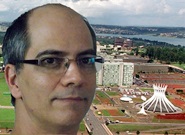João Mendonça:
“The message of
Spiritism must
come in many art
forms to reach
the hearts of
those who need
consolation and
hope”
The director of
the Department
of Spiritist
Arts and Culture
from the
Spiritist
Federation of
the Brazilian
Federal District
tell us about
his early days
in Spiritist art
and highlights
the need to
encourage the
formation of new
artists
 |
João Batista de
Mendonça
(photo)
lives in the
Brazilian
capital,
Brasília, where
he is is the
director of the
Department of
Spiritist Arts
and Culture from
the Spiritist
Federation of
the Federal
District. He is
also a member of
the board of the
Brazilian
Association of
Spirist Arts (ABRARTE).
He is also
co-author of the
book published
in 2014, “Arts
in
|
|
the Spiritist
Centre –
Planning and
Practice”, in
which he talks
about music and
Spiritism. |
What has
prompted you to
work with
Spiritist art?
My family was
always involved
with music. My
brother and my
father used to
play the guitar.
I used to play
electric bass
and used to play
alongside
friends in bars
in Brasília.
When I began my
involvement with
Spiritism in
Brasília, my
friend Armando
Reis lent me the
keys to many
Spiritist songs.
I joined ABRARTE
in 2009 and
became an active
member of the
group of
Spiritists from
across Brazil
who are involved
in the arts,
seeking new ways
of encouraging
this new
movement.
What method do
you employ in
the preparation
of your artwork?
I have invested
a lot o my
energy on the
Alegria Cristã
(Christian
Happiness)
project for
children. After
I became
familiar with
the repertoire I
began working
closely with the
children,
passing on the
Christian
message through
music. The
teaching process
carries on in
the classroom. I
have learned a
great deal from
the message and
I hope the young
ones have
learned them
too.
What is your
assessment of
the production
of Spiritist art
at the moment?
After meeting
the brothers and
sisters from
ABRARTE, I can
say that the
future of the
arts in the
Spiritist
Movement is in
with the youth
movement. That
is where most of
the artwork
comes from. We
have seen great
development in
recent year, but
there is a long
way to go.
What are the
main obstacles
you are still
facing?
I believe that
one of the
biggest
challenges is
the lack of
knowledge of the
importance of
the arts in the
life of a Spirit
in its process
of education and
development.
Spiritist books
and magazines
have always
reminded us of
the importance
of the arts for
Spirtism. Allan
Kardec’s
Spiritist
Magazine
published many
articles about
arts. Emmanuel
says in “O
Consolador” (The
Consoler),
question 161,
that the artist
must be the
“medium of the
eternal
beauties”. André
Luiz shows in
his books,
including “Nosso
Lar” (Our Home)
artistic
activities in
many levels and
forms. In the
Gospel in the
Home at the
house of Laura,
in his book,
Lísias and his
sisters are play
musical
instruments
before
communicating
with the father,
who was already
incarnated.
Spiritist
literature is an
incentive to me
to work on
Spiritist art.
What we really
need to do it to
study, otherwise
we will be left
only with
prejudices and
misconceptions.
We need to
continue to
study the
subject and
those in charge
of the Spiritist
Movement need to
pay more
attention to
this aspect. The
largely
disregarded work
of Eurípedes
Barsanulfo in
the Allan Kardec
school in
Sacramento is a
good example of
applying the
arts to help
spiritual
development.
What are your
plans for the
future,
particularly
regarding
Spiritist art?
My dream is the
day when well
produced arts
events will be
integrated with
other events,
not only in
Spiritist
Centres, but
also on the
stages of
theatres,
schools, old
people’s homes
and nurseries,
with the message
of Spiritism
coming in many
art forms to
reach the hearts
of those who
need consolation
and hope.
What is your
final message to
our readers?
As we are all
immortal
Spirits, we
will, one day,
come to the
point where we
will practice
art as a way of
building a
successful life
in many aspects.
The biggest
artist we have
knows is our
Master Jesus,
who participated
in the
construction of
the earth, which
is pure poetry.
Look, hear and
feel those who
have artistic
sense in
themselves. And
we all do,
because the
Creater gives us
that all the
time!